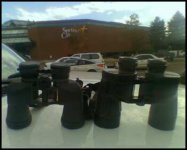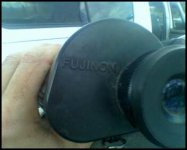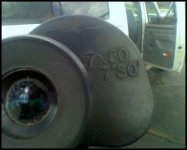Great post, Bob. What I find interesting is that the exit pupil at highest detail was 3.3. This echos my experience with spotting scope usage in terms of magnification trade off, though I observe purely for aesthetic, as has been differentiated in this thread, and don't mind turning it down to get a better view.
But one question - if you were looking for the ten-pointer, which setting would you use to locate the animal?
Matt...
I just wrote a five-paragraph answer. I moved them to the bottom of this post because I went back outside with my Fujinon FMT-SX 7x50 and Pentax DCF ED 10x50 binocualars.
8:30 p.m.
Two deer are foraging under my neighbor's apple tree. The Fujinon 7x50 reveals the outline of the deer quite well, as well as the surrounding grass and orchard. I put the Pentax 10x50 to my eyes and the shape of the deer, as well as the surrounding grass and orchard are darker. Detecting the shape of things is more difficult in the darker view of the 10x50. However, I do see more detail in the deer with the 10x50. The deer begin to switch a warning sign with their white tail and move away between some houses out of my eyesight. I sit and reflect a few minutes.
I pick up the 7x50 again and the lawn is brighter than with my naked eye. I pass over a clump in my neighbor's yard. A clump that has not been there before. I cannot make out the detail in the clump, just the shape. I pick up the 10x50 and see that ears reveal the clump to be a rabbit foraging in the lawn. The rabbit takes a couple of hops. I go back to the 7x50. As the clump moves across the lawn in slow hops I can now detect it to be a rabbit--more from the hops than anything else. Back to the 10x50, much more detail in the rabbit, however, the shape of the rabbit and the surrounding lawn is darker than with the 7x50.
Bottom line, the 7x50 reveals a much more aesthetic view, which I prefer, because of the brighter surrounding and wider FOV. However, it is the 10x50 that first revealed the clump to be more than a clump--a rabbit eating my neighbor's clover.
I am reminded of your full moon resolution test. You reported the larger exit pupil revealed a brighter chart, but no more detail than the smaller exit pupil.
I also think about the 7x50's original marine purpose--to reveal shore line and rocks for ships nearing land. These are surroundings and shapes. What is important to mariners is the coast line and if any outlying rocks or piers may present danger--they are not interested in the surface texture details of the rocks or the piers. For detail, such as the identification of another ship, mariners often switch to the larger 16x70--they are no longer interested in surroundings and shapes, they want details.
Although animal details are revealed more through magnification, I find that I personally prefer the aesthetics of the larger exit pupil and smaller magnification--the animals in their environment.
. . .
Now, back to your question about which eyepiece would I use if looking for a ten-point buck.
First, let me say the ZenithStar scope would not make a very good hunting scope because the scope exterior is white with bright shiny knobs.
Next, I think the selection of hunting optics depends greatly upon the terrain or environment. Specifically, are you going to be in close terrain or open terrain? Here in Kentucky, particularly the central and eastern portions of the state, the hunting will most likely take place in hilly forest terrain. Spotting deer is not a challenge of distance viewing, but detecting their movement among the brush, trees, and ravines. What's more, the deer is not visible on the move except for a few seconds at best. A scope of any specs would be more of a hinderance than a help. A good pair of hunting binoculars would be of greater value. Paricularly, those with coatings to accent red or brown colors (the color of animal fur), such as the Steiner Predator or Minox models.
Now this changes if you are hunting on cleared farm land, where deer emerge from the forest to forage pasture land, crops, or cattle feed. In such open spaces--which probably are not consedered open spaces at all in the western United States--the deer can be viewed from greater distances and for longer periods of time as they move in and out of the forest across the grassland.
In close forest terrain I think a binocular with narrow depth of view, wide field of view, and quick focus would be the thing more than higher magnification or a bright exit pupil. But, since we are talking magnification and exit pupil in this thread, more than other features, I will have to say a 7x or 8x would be adequate for close forest terrain with a 4-5mm exit pupil for day and 5-6mm exit pupil for dawn, dusk, or heavy forest canopy.
At twilight, if I found that I had lost my 7x50 or 8x42 binocular, and discovered that I had packed some Camouflage netting in my backpack, and heard a rustling up the ravine 50-100 yards ahead--I would ever so quietly (with praying mantis slowness) drape the Camouflage over the ZenithStar 70mm scope, and select the 40 mm eyepiece (11x70 / 6.6mm exit pupil / 6.5° FOV) because of the bright exit pupil and wide FOV. If I saw for sure it was a large deer making its way down the ravine, I would switch to the 20mm (22x / 3.3mm exit pupil / 3.3° FOV) to count the points. Maybe I will make too much noise or my movements are detected by the wary buck and he is spooked and veers out of sight.
But then, I am not a hunter with a tag in my pocket, with both an empty wall and empty freezer to fill. A hunter would probably use binoculars to detect the deer moving down the ravine and the 20mm eyepiece would already be in the scope because the hunter would have predetermined the spot where a deer would come down the ravine.
...Bob
Kentucky






